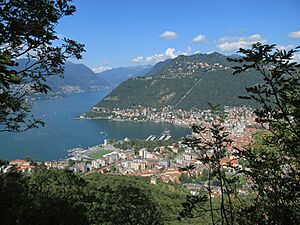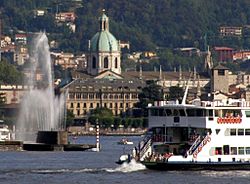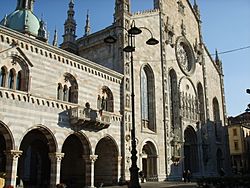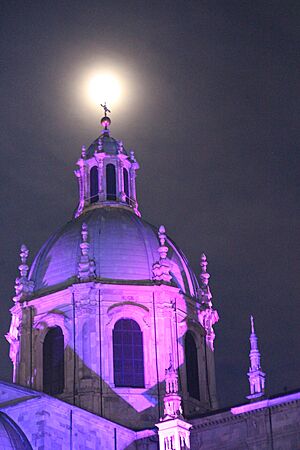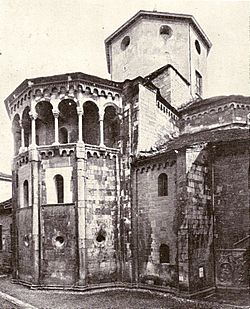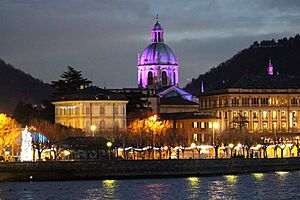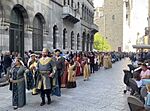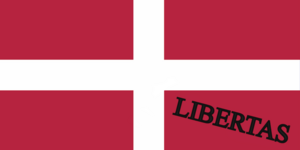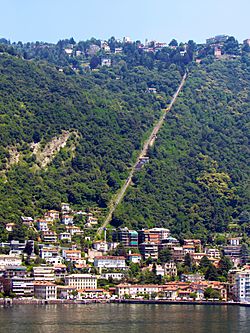Como facts for kids
Quick facts for kids
Como
Còmm (Lombard)
|
|||
|---|---|---|---|
| Città di Como | |||

View of Como from Baradello Castle
|
|||
|
|||
| Country | Italy | ||
| Region | Lombardy | ||
| Province | Como (CO) | ||
| Roman foundation | 196 BC | ||
| Frazioni | Albate, Borghi, Breccia, Camerlata, Camnago Volta, Civiglio, Garzola, Lora, Monte Olimpino, Muggiò, Ponte Chiasso, Prestino, Rebbio, Sagnino, Tavernola | ||
| Area | |||
| • Total | 37.14 km2 (14.34 sq mi) | ||
| Elevation | 201 m (659 ft) | ||
| Population
(31 October 2022)
|
|||
| • Total | 84,250 | ||
| • Density | 2,268.4/km2 (5,875.2/sq mi) | ||
| Demonym(s) | Comaschi | ||
| Time zone | UTC+1 (CET) | ||
| • Summer (DST) | UTC+2 (CEST) | ||
| Postal code |
22100
|
||
| Dialing code | 031 | ||
| Patron saint | Saint Abbondio | ||
| Saint day | 31 August | ||
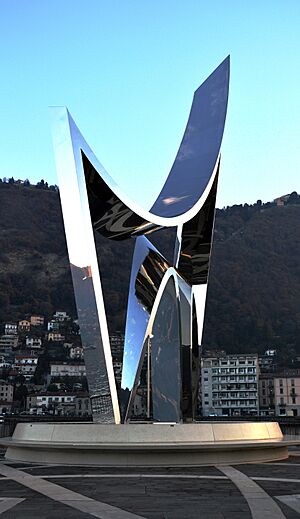
Como is a beautiful city in Lombardy, Italy. It's the main city of the Province of Como. Como is famous for being very close to Lake Como and the Alps mountains. This makes it a popular place for tourists to visit.
The city has many amazing things to see. You can find old churches, lovely gardens, and interesting museums. There are also grand palaces and a famous theater. Some of the most well-known spots include the Duomo (the main church), the Basilica of Sant'Abbondio, and the beautiful Villa Olmo. You can also visit the public gardens with the Tempio Voltiano, which is a museum about a famous scientist.
Many important people were born in Como. These include the ancient writers Pliny the Elder and Pliny the Younger. Also, Pope Innocent XI and the scientist Alessandro Volta were from here. Antonio Sant'Elia, a forward-thinking architect, was also born in Como.
Contents
History of Como: A Journey Through Time
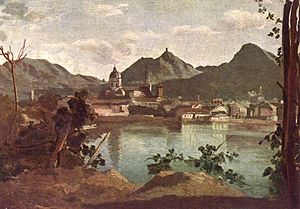
How Old is Como?
People have lived in the hills around Como since the Iron Age. This was a long, long time ago! A Celtic tribe called the Orobii lived here first. Later, another Celtic group, the Insubres, came to the area.
Around 100 BC, the Romans took control. The city center was originally on the hills. But Julius Caesar decided to move it to where Como is today. He had the swamp near the lake drained. Then, he planned the city with straight, crossing streets, just like Roman cities. The new town was called Novum Comum. In 2018, many old gold coins from 474 AD were found in a basement here.
Como in the Middle Ages
After the fall of the Western Roman Empire, Como was ruled by different groups. These included the Goths, the Byzantines, and then the Langobards. The Langobards were a strong group from Scandinavia. They built the Lombard Kingdom in Italy. Under their rule, Como grew because of a road that connected Italy and Germany. This helped with trade.
In 774, the Franks, led by Charlemagne, took over Como. The city then became a busy place for trading goods.
When Como Ruled Itself
Around the 11th century, Como became a "Commune." This meant it was like a self-governing city. Important families and later all free men joined together. They wanted to be independent, especially from nearby Milan. The bishop of Como became like the city's leader. Citizens met in the "Broletto" (Town Hall) to make decisions. They had their own laws for trade, farming, and keeping order.
Como grew rich and powerful because of its location on Lake Como. It was also on an important trade route that linked Italy with Germany.
During this time, Como and Milan became big rivals. Milan wanted to control more land. This led to a big war between Como and Milan in 1118, called the Decennial War between Como and Milan. At first, Como did well, but they lost the war in 1127. Milanese soldiers destroyed almost everything in Como, except the churches.
But things changed when Frederick Barbarossa became the Holy Roman Emperor. He helped Como become independent from Milan again. The people of Como got their revenge when Milan was destroyed in 1162! Frederick helped Como rebuild its walls and towers. Many of these walls are still standing today.
Como stayed loyal to Frederick Barbarossa. He gave Como special rights in 1175. This allowed the city to elect its own leaders.
The Rusca Family and Milan's Rule
A powerful family called the Rusca (also known as Rusconi) became very important in Como. They were leaders of the Ghibelline group in the city. In 1276, Loterio Rusca became "Lord of the People." He even made a peace treaty with Milan that was good for Como. The Rusca family became lords of Como and other nearby towns.
But in 1335, another war started between Como and Milan. Milan won this time, and Como became part of the Duchy of Milan. The people of Como tried to get their freedom back many times. In 1447, they even started the "Republic of Saint Abundius." But in 1450, Como was finally defeated and became part of the Duchy of Milan again.
Como in Modern Times
After this, Como's history was tied to the Duchy of Milan. It was ruled by the French, then the Spanish, and then the Austrians. Napoleon ruled Lombardy from 1796 to 1815. Then, the Austrians took over again. In 1859, Giuseppe Garibaldi arrived, and Como became part of the new Kingdom of Italy.
20th and 21st Centuries
At the end of World War II, Benito Mussolini was captured and shot near Lake Como while trying to escape.
In 2010, some people in Switzerland suggested that Como and its area should join Switzerland. This shows how close Como is to the Swiss border.
Geography and Climate: Where is Como?
Como is located at the southern end of Lake Como. It's about 40 kilometers (25 miles) north of Milan. The city actually borders Switzerland! It's also close to other Italian towns like Cernobbio and Torno. Nearby big cities include Varese and Lugano in Switzerland.
Como's Weather
Como has a humid subtropical climate. This means it has warm, humid summers and mild winters. Winters used to be colder, but recently, they have become warmer. Spring and autumn are pleasant. Summers can be hot and humid. It often rains more in spring, and summer can have thunderstorms.
Main Sights: What to See in Como
Churches to Explore
- Como Cathedral: This huge church started being built in 1396. Its front was finished in 1457. It has cool statues of the famous writers Pliny the Elder and Pliny the Younger. The inside has beautiful old paintings and tapestries.
- San Fedele: This Romanesque church was built around 1120. It has a famous door with medieval carvings.
- Basilica of Sant'Abbondio: This Romanesque church was opened in 1095. Inside, you can see paintings from the 11th century and frescoes from the 14th century.
- San Carpoforo: This church from the 11th century is said to be built on an old temple.
Cool Buildings and Monuments
- Broletto: This is the old town hall of Como.
- Casa del Fascio: This building is a famous example of modern European architecture.
- Teatro Sociale: A theater built in 1813.
- Villa Olmo: This grand villa was built starting in 1797. Many famous people like Napoleon and Giuseppe Garibaldi stayed here. Today, it hosts art shows.
- Monumental Fountain: Also called "Volta's Fountain," this monument honors Alessandro Volta and his invention, the battery. It's a tall structure made of spheres and rings.
- Ancient walls: You can still see parts of the medieval walls that protected the city.
- Tempio Voltiano: A museum all about Alessandro Volta, the famous scientist from Como.
- Life Electric: A modern sculpture by Daniel Libeskind.
- Castello Baradello: A small medieval castle that looks over the town. It's all that's left of a fortress built around 1158 by Frederick Barbarossa.

Economy: How Como Makes Money
Como used to be famous for its silk factories. In the 1970s, it made more silk than China and Japan! But now, there's a lot of competition from Asia. So, many silk companies have closed.
Today, Como is part of Milan's big city area. Many people from Como work in Milan or in nearby Swiss towns like Lugano. They work in factories, hospitals, and hotels. Wages are higher in Switzerland, so it's worth the commute.
Tourism is now very important for Como. Since the late 1990s, more and more bars, restaurants, and hotels have opened. In 2023, about 400,000 people stayed overnight in Como.
The city and Lake Como have been used as filming locations for many movies. Also, celebrities have bought homes by the lake. All of this has made Como a very popular place for tourists from all over the world.
People of Como: Demographics
The population of Como grew to almost 100,000 people in the 1970s. This was when the silk industry was booming. But as factories closed, the population went down.
Now, the population is growing again, partly because more people are moving here from other countries. As of January 2023, Como had about 83,700 people. About 12,000 of them were from other countries.
Here's where people in Como are from:
| Pos. | Origin | % |
|---|---|---|
| 1 | Italy | 86% |
| 2 | Europe | 5.3% |
| 3 | Asia | 4.1% |
| 4 | Africa | 2.8% |
| 5 | America | 1.8% |
| 6 | Oceania | 0.02% |
Culture: What to Do in Como
Museums to Visit
Como has many museums and places for exhibitions:
- Museo Archeologico "P. Giovio" – An archeology museum.
- Garibaldi Museum (Como) – A museum about Giuseppe Garibaldi, a hero of Italy.
- Tempio Voltiano – A museum about Alessandro Volta's work.
- Villa Olmo – Hosts different exhibitions.
- Museo Didattico Della Seta – An educational museum about silk.
- Pinacoteca Civica – A museum with paintings and art from different time periods.
Delicious Food
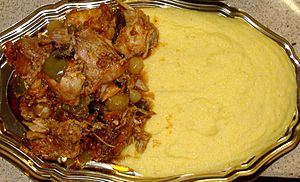
Polenta is a very popular dish in Como. It's made from corn flour and buckwheat. People usually eat it in winter with meat, cheese, or even fish. A special dish is Polenta e Misultin, which is polenta with a type of fish from the lake.
Another traditional dish is Risotto con Filetti di Pesce Persico. This is European perch fish risotto, made with fish from Lake Como.
Palio del Baradello: A Medieval Festival
In Como, there's a fun medieval festival every year called Palio del Baradello.
It started in 1981. The festival tells the story of what happened in 1159. That year, the Holy Roman Emperor Frederick Barbarossa visited Como. Como helped him fight against other cities in Lombardy. The Emperor gave Como its freedom back, which it had lost in a long war against Milan. Together, Como and the Emperor defeated Milan.
This festival celebrates these important moments. Actors dress up as Frederick Barbarossa and other historical figures. Citizens also wear medieval clothes.
During the Palio del Baradello, the city is divided into historical areas called "Borghi." These include Tavernola, Quarcino, and Camerlata. The different areas compete in races.
On the last day, there's a big parade. Everyone marches through the town in medieval costumes. There are animals, wagons, and even replicas of old war machines! The Emperor then announces which area won the competition.
Symbols of Como
City's Coat of Arms
The symbol of Como is a white cross on a red background. This symbol was used in the Middle Ages to show that the city supported the Ghibelline group. The first time this symbol was mentioned was during the war between Como and Milan (1118–1127).
Later, the word 'LIBERTAS' (which means 'Freedom' in Latin) was added to the symbol. This motto probably appeared when Como gained its freedom from Milan with the help of Emperor Frederick Barbarossa. The motto was sometimes removed when Milan controlled Como, but it was always brought back when Como became independent again.
The coat of arms often has a curved shape and is surrounded by flowers. A crown is also an important part of the symbol. In 1819, Como was recognized as a "Royal Town," and a crown officially became part of its coat of arms.
Flags of Como
Throughout history, Como has used a flag with a white cross on a red background. Around the 12th century, a version of this flag included the word "LIBERTAS" in the bottom right corner. You can see this flag displayed at the town hall today.
Transportation: Getting Around Como
Trains
Trains connect Como to other major cities in Lombardy. There are two main train stations: Como San Giovanni and Como Nord Lago. Como San Giovanni is also a stop for international trains going between Milan and places like Zürich and Basel. This makes Como easy to reach from other parts of Europe.
There's also a funicular (a special cable car) that connects the center of Como with Brunate. Brunate is a small village high up on a mountain.
Buses and Taxis
Local buses run within the city and connect Como to other towns in its province. There are also bus lines that go to Varese. You can also find taxi services provided by the city.
Boats on the Lake
Boats and hydrofoils (fast boats) connect Como with most of the villages around Lake Como. This is a great way to explore the lake!
Airports Nearby
The closest airports for scheduled flights are Malpensa International Airport, Milano Linate, and Orio al Serio International Airport. Lugano Airport in Switzerland is also nearby, mainly for smaller regional and private flights.
Aero Club Como
Como is home to the oldest seaplane club in the world, the Aero Club Como. They have seaplanes for flight training and local tours. They also have some cool old seaplanes, like a 1935 Caproni Ca.100. There's a hangar right by the lake where they keep and fix the planes.
Sports in Como
Como has some notable sports teams. The ASDG Comense 1872 is a women's basketball team that has won the FIBA EuroLeague Women twice. There's also Como 1907, a football (soccer) team.
For tourists, there are many fun activities like pedal boating, fishing, and walking. Como also hosts a big tennis tournament every year called the Città di Como Challenger. Many top tennis players come here because they enjoy the relaxed atmosphere more than the busy US Open.
International Friends
Como is twinned with these cities around the world:
 Fulda, Germany, since 1960
Fulda, Germany, since 1960 Tokamachi, Japan, since 1975
Tokamachi, Japan, since 1975 Nablus, Palestine, since 1998
Nablus, Palestine, since 1998 Netanya, Israel, since 2004
Netanya, Israel, since 2004
See also
 In Spanish: Como para niños
In Spanish: Como para niños




